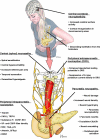Pain mechanisms in chronic pancreatitis: of a master and his fire
- PMID: 21153480
- PMCID: PMC3026929
- DOI: 10.1007/s00423-010-0731-1
Pain mechanisms in chronic pancreatitis: of a master and his fire
Abstract
Background: Unraveling the mechanisms of pain in chronic pancreatitis (CP) remains a true challenge. The rapid development of pancreatic surgery in the twentieth century, usage of advanced molecular biological techniques, and emergence of clinician-scientists have enabled the elucidation of several mechanisms that lead to the chronic, complicated neuropathic pain syndrome in CP. However, the proper analysis of pain in CP should include three main arms of mechanisms: "peripheral nociception," "peripheral/pancreatic neuropathy and neuroplasticity," and "central neuropathy and neuroplasticity."
Discussion: According to our current knowledge, pain in CP involves sustained sensitization of pancreatic peripheral nociceptors by neurotransmitters and neurotrophic factors following neural damage. This peripheral pancreatic neuropathy leads to intrapancreatic neuroplastic alterations that involve a profound switch in the autonomic innervation of the human pancreas via "neural remodeling." Furthermore, this neuropathy entails a hyperexcitability of spinal sensory second-order neurons, which are subject to modulation from the brainstem via descending facilitation. Finally, viscerosensory cortical areas react to this central sensitization via spatial reorganization and thus a central neuroplasticity. The present review summarizes the current findings in these arms of mechanisms and introduces a novel concept to consistently describe pain in CP as a "predominantly neuropathic," "mixed-type" pain.
Figures

Similar articles
-
Fate of nerves in chronic pancreatitis: Neural remodeling and pancreatic neuropathy.Best Pract Res Clin Gastroenterol. 2010 Jun;24(3):311-22. doi: 10.1016/j.bpg.2010.03.001. Best Pract Res Clin Gastroenterol. 2010. PMID: 20510831 Review.
-
Pancreatic neuropathy results in "neural remodeling" and altered pancreatic innervation in chronic pancreatitis and pancreatic cancer.Am J Gastroenterol. 2009 Oct;104(10):2555-65. doi: 10.1038/ajg.2009.380. Epub 2009 Jun 30. Am J Gastroenterol. 2009. PMID: 19568227
-
Evidence of pancreatic neuropathy and neuropathic pain in hereditary chronic pancreatitis.Pancreatology. 2013 Nov-Dec;13(6):629-30. doi: 10.1016/j.pan.2013.05.009. Epub 2013 Jun 10. Pancreatology. 2013. PMID: 24280582
-
Neuronal Transforming Growth Factor beta Signaling via SMAD3 Contributes to Pain in Animal Models of Chronic Pancreatitis.Gastroenterology. 2018 Jun;154(8):2252-2265.e2. doi: 10.1053/j.gastro.2018.02.030. Epub 2018 Mar 2. Gastroenterology. 2018. PMID: 29505748 Free PMC article.
-
Unraveling the mystery of pain in chronic pancreatitis.Nat Rev Gastroenterol Hepatol. 2012 Jan 24;9(3):140-51. doi: 10.1038/nrgastro.2011.274. Nat Rev Gastroenterol Hepatol. 2012. PMID: 22269952 Review.
Cited by
-
Sprouted innervation into uterine transplants contributes to the development of hyperalgesia in a rat model of endometriosis.PLoS One. 2012;7(2):e31758. doi: 10.1371/journal.pone.0031758. Epub 2012 Feb 21. PLoS One. 2012. PMID: 22363725 Free PMC article.
-
Systematic mechanism-orientated approach to chronic pancreatitis pain.World J Gastroenterol. 2015 Jan 7;21(1):47-59. doi: 10.3748/wjg.v21.i1.47. World J Gastroenterol. 2015. PMID: 25574079 Free PMC article. Review.
-
Cytokine profiles in patients receiving antioxidant therapy within the ANTICIPATE trial.World J Gastroenterol. 2013 Jul 7;19(25):4001-6. doi: 10.3748/wjg.v19.i25.4001. World J Gastroenterol. 2013. PMID: 23840145 Free PMC article. Clinical Trial.
-
Earlier surgery improves outcomes from painful chronic pancreatitis.Medicine (Baltimore). 2018 May;97(19):e0651. doi: 10.1097/MD.0000000000010651. Medicine (Baltimore). 2018. PMID: 29742705 Free PMC article.
-
The impact of MFG-E8 in chronic pancreatitis: potential for future immunotherapy?BMC Gastroenterol. 2013 Jan 16;13:14. doi: 10.1186/1471-230X-13-14. BMC Gastroenterol. 2013. PMID: 23324439 Free PMC article.
References
-
- Hesse H. In Schmerzen. Die Neue Rundschau. Berlin: S. Fischer Verlag; 1934. p. 629.
-
- Hatayama K. A clinical investigation of chronic pancreatitis—comparative study between alcoholic pancreatitis and non-alcoholic pancreatitis. Gastroenterol Jpn. 1978;13(2):127–139. - PubMed
-
- Bockman DE, Buchler M, Malfertheiner P, Beger HG. Analysis of nerves in chronic pancreatitis. Gastroenterology. 1988;94(6):1459–1469. - PubMed
Publication types
MeSH terms
LinkOut - more resources
Full Text Sources
Medical
Miscellaneous

